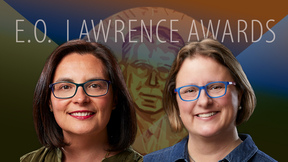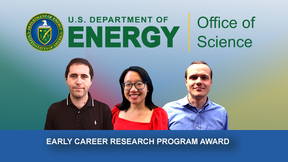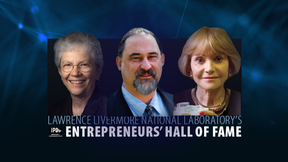Back
The next generations of lithium-ion batteries require higher energy and power densities at a lower cost. Current battery manufacturing, based on slurry casting and coating, is struggling to further improve these key metrics. Lawrence Livermore National Laboratory (LLNL) is partnering with Ampcera Inc. to develop solvent-free Laser Powder Bed Fusion (L-PBF) additive…
Recent advances in pre-programmed architected materials could enable new functions that can evolve in response to their environments or external stimuli, according to Lawrence Livermore National Laboratory (LLNL) researchers. In a paper published by Nature Reviews Materials, LLNL researchers provide an overview of the progress made in responsive architected materials that…
Two Lawrence Livermore National Laboratory (LLNL) scientists are recipients of the prestigious 2021 E.O. Lawrence Award that recognizes mid-career U.S. scientists and engineers for exceptional scientific, technical and engineering achievements related to the broad missions of the Department of Energy (DOE) and its programs. Jennifer Pett-Ridge was recognized for her…
On June 15, Department of Energy Under Secretary for Nuclear Security and Administrator of the National Nuclear Security Administration (NNSA) Jill Hruby dedicated two critical infrastructure projects at Lawrence Livermore National Laboratory (LLNL), part of a three-day visit to the Lab. Hruby attended ribbon-cutting ceremonies for the Exascale Computing Facility…
Improving our understanding of the physical characteristics of plutonium as it ages is a vital aspect of maintaining the reliability of the U.S. nuclear deterrent in the absence of underground testing. The recent installation of a new plutonium target fabrication facility at Lawrence Livermore National Laboratory (LLNL) aims to further progress toward that goal…
Lawrence Livermore National Laboratory (LLNL) and the rest of the Department of Energy (DOE) national laboratories produce an astronomical amount of data every year. As the volume of data generated from DOE high performance computing (HPC) continues to reach increasing scales of magnitude and new levels of importance for decision-making, where does all this data go and how…
Three scientists from Lawrence Livermore National Laboratory (LLNL) are recipients of the Department of Energy’s (DOE) Office of Science Early Career Research Program award. Mimi Yung, John Despotopulos and Timofey Frolov are among 83 awardees receiving the recognition. Under the program, typical awards for DOE national laboratory staff are $500,000 per year for five years…
The private-public Accelerating Therapeutic Opportunities in Medicine (ATOM) consortium is showing “significant” progress in demonstrating that high performance computing (HPC) and machine learning tools can speed up the drug discovery process, ATOM co-lead Jim Brase said at a recent webinar. Brase, Lawrence Livermore National Laboratory’s (LLNL) deputy associate director…
The Department of Energy’s (DOE) Technology Transfer Working Group (TTWG) recently awarded two Lawrence Livermore National Laboratory (LLNL) employees with “Best in Class” awards during their May 13 spring meeting in Washington, D.C. Annemarie Meike, a business development executive within the Innovation and Partnerships Office (IPO), received the Innovative Lab Technology…
The January 2022 eruption of the Hunga volcano in Tonga was the largest volcanic eruption in the 21st century, and the largest recorded since the 1991 eruption of Mount Pinatubo. New research by an international team from 17 countries including Lawrence Livermore National Laboratory (LLNL) scientist Keehoon Kim demonstrates that, based on atmospheric pressure waves…
The U.S. Department of Energy’s (DOE) National Nuclear Security Administration (NNSA) today announced the award of an $18 million contract to Cornelis Networks for collaborative research and development in next-generation networking for supercomputing systems at the NNSA laboratories. The Next-Generation High Performance Computing Network (NG-HPCN) project for the NNSA’s…
The Department of Energy (DOE) today launched the spring 2022 solicitation for the High Performance Computing for Energy Innovation (HPC4EI) initiative, seeking proposals from industry that address key energy and decarbonization-related challenges in domestic manufacturing. The latest HPC4EI funding opportunity is sponsored by the HPC4Manufacturing (HPC4Mfg) Program, one…
Lawrence Livermore National Laboratory (LLNL) researchers have refined the measurement of the gamma (γ)-to-neutron branching ratio in deuterium-tritium (D-T) fusion reactions. This reaction is a viable candidate for fusion energy, as it is known to have the largest cross section at center-of-mass energies below 500 keV. There are different branches of this reaction. These…
Lawrence Livermore National Laboratory (LLNL) has signed a memorandum of understanding (MOU) with the city of Livermore to collaborate on advancing climate action in Livermore and build community-wide resilience to climate change impacts. The city’s Climate Action Plan (CAP), anticipated to be adopted by the Livermore City Council this summer, will create a roadmap to…
The National Aeronautics and Space Administration (NASA) announced April 15 it has awarded Lawrence Livermore National Laboratory (LLNL) and a private company with funding to develop LLNL’s revolutionary volumetric additive manufacturing (VAM) 3D printing technology to produce artificial cartilage tissue in space. The award, one of eight projects selected by NASA’s In…
If humans decrease their greenhouse gas emissions to the atmosphere, how quickly would we detect a slowdown in global warming? In a recent study published in Nature Communications, Lawrence Livermore National Laboratory (LLNL) climate scientist Mark Zelinka and collaborators developed a novel approach to more quickly see the temperature response to strong emissions…
Researchers from Lawrence Livermore, Los Alamos and Sandia national laboratories have teamed up to better understand the strength of tantalum, an important platform-development material in the tri-lab community. The work builds from the understanding that tantalum remains in a single solid phase across the full range of conditions examined. This includes conditions…
The national economy is reenergizing, quite literally. In 2021, Americans used 5% more energy than in 2020, according to the most recent energy flow charts released by Lawrence Livermore National Laboratory (LLNL). Each year, LLNL releases flow charts that illustrate the nation's consumption and use of energy. In 2021, Americans used 97.3 quads (quadrillion BTU) of energy,…
Lawrence Livermore National Laboratory (LLNL) scientists have simulated the hydrogen storage reactions in a promising material and discovered why hydrogen uptake slows as the material absorbs hydrogen, providing insight that could be used for improvements. Improving hydrogen storage in solid-state materials depends on a better understanding of multistep chemical reactions…
One current and two former Lawrence Livermore National Laboratory (LLNL) scientists have been inducted into the Laboratory’s Entrepreneurs’ Hall of Fame (EHF). The trio, who represent the third class of inductees into the Lab’s EHF, have been honored for developing technologies during or after their Lab careers that created major economic impacts or spawned new companies. …
























